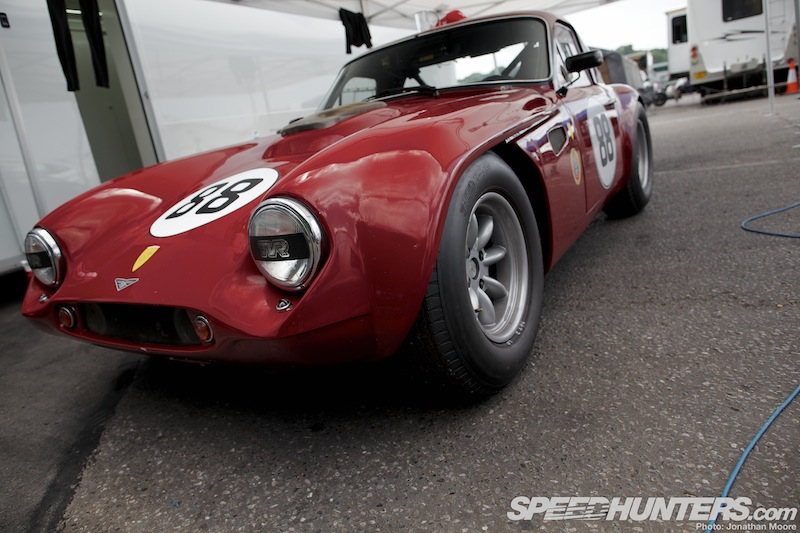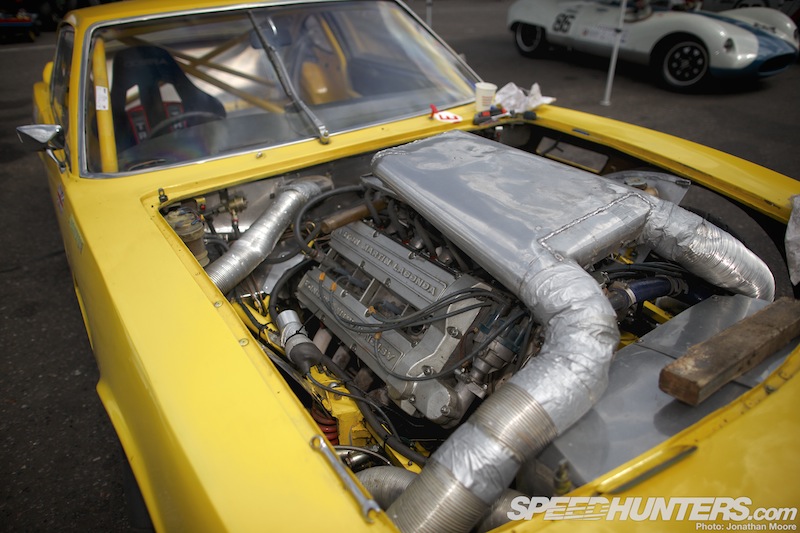
The Aston Martin Owner’s Club meeting at the Brands Hatch Centenary Meeting provided a whole lot more eye candy than just the produce of Newport Pagnell and Gaydon – though that would have been enough to satisfy most – and the chance to get a good look at a whole host of rare racers. This set of spotlights kicks off with a quartet where it’s all about what’s up front, before taking a look at what’s hanging out back for the final pair.

First up, the hugely long, unmistakeable nose of a Marcos. Born from the ’60s, Marcos GTs became the bedrock of the national British GT series during the ’90s, but it’s the grace of their early output that has always intrigued me – such as this 1963 1800GT. Inside the long nose was the inline four from a Volvo P1800, and the 1800GT was based on a wood-ply chassis. A carbon fibre tech centre this is not, but that doesn’t make it any less of an exciting car to race.

I just think they always looked ahead of their time. The curving rear shoulders and almost Aston grille-like shape of the Kamm tail are a signature of the majority of Marcos’ output, and dare I say that its long lines evoke a more muscular (and flattened!) E-Type. The colour scheme of this 1800GT was particularly effective as well – and the numberplate appropriate!

Peering through the porthole in the window, you get an idea of how cramped things are in the cockpit. At least, there’s actually no real shortage of space side to side, but with the big and boxy transmission tunnel bisecting the car, the driver is shoved right up against the door, down low in a narrow aperture. And when I say low, I mean really low. The roofline is just 43 inches off the ground!

Then, just think about having six feet of bonnet in front. If you take the driver’s eye-line and extrapolate that out, there must be about 20 feet of dead zone in front of the car… Not really being able to see has always been a classic Marcos trait (think of the brutal LM600 Evo of the ’90s for instance). A stunning racer though.

Moving across to my first Aston Martin, I’m going to slightly cheat and show a couple of cars in one. Brands Hatch showed off two Le Mans racers from Aston Martin, the DP212 and 214 from ’62 and ’63. Yet more rare sights on a weekend rich with surprises.

The 212 was based on a DB4GT, with an elongated nose and tail to cope with the high speeds of Le Mans. The original car had a more rounded tail and suffered from terrible stability at speed; it currently sports the Kamm tail that was added following tests after the 24 Hours, a design that was then also utilised for the DB6 road car and the following year’s Le Mans.

Graham Hill and Richie Ginther drove the DP212 in ’62 – it wasn’t stable, but it was fast, even leading early on before being hobbled by piston failure six hours in. This unique DP212 has been in pretty much constant competition ever since, and is still the original chassis underneath. Fifty years not out!

The DP212 was replaced for 1963 by a pair of DP214s, using lessons learned from the previous year. The body was wider still, and the Kamm tail cured the stability problem, but despite prodigious speed cracked pistons once again took the cars out of contention at Le Mans.

Of the two original cars, one was destroyed in a race at the Nürburgring in 1964 and the other survives despite a big crash at the Goodwood Revival last year. This car, owned by the same driver as the genuine DP212, is a ’70s recreation, but that didn’t make it any less upsetting when I witnessed him coming round Sheene curve at Brands to find another car stationary and broadside across the track. Luckily it was only a glancing blow to one corner…

I talked in my first story from AMOC about blunt force trauma, so it’s time to turn to a couple of cars that completely follow that ethos: stuffing big V8s under the bonnet and turning them all the way up. With TVR supposedly near to being back in business, I thought it’s about time we paid tribute to the original Griffith, with this 400 from 1965.

This is another Anglo-American success story in the mould of the Cobra. The American Griffith Motorcar Company took the UK’s four-cylinder TVR Grantura MkIII and shoe-horned a 4.7-litre Ford 289 ‘HiPo’ Windsor V8 into it.

The results were predictable. Three hundred V8 horses in a chassis akin to a go-kart. They’re as fun to watch (and hear) now as they ever were.

The Griffith was a squat car with a squashed profile: just check out the difference in track between front and rear. The acres of glass at the rear gave great visibility…

… but with the short wheelbase the story was similar to the Marcos. Worse in fact, as the pedals are even more offset. A car for long-distance racing this isn’t! Still, imagine driving one…

From a short wheelbase V8 go-kart to a huge battleship of a GT: an Aston Martin V8 from 1976.

Where is subtlety? Gone. Destroyed with a hammer. Three of these glorious brutes were out at Brands, with this being the least subtle of the lot. It was awesome to watch, nosing its way round corners before rearing up and blasting down the straights.

The road car was already fast, despite its size and weight, so the stripped-out race cars were even more full-on, especially with this firepower up front: a 5.4 litre development of the Aston Martin Lagonda V8.

Inside, you’re definitely not suffering from the cramped conditions of the TVR or Marcos…

… in fact, even the passenger seemed pretty comfortable!

From the monster big to the teensy small, and an Abarth 850TC from 1963 complete with obligatory suicide doors.

The Abarth badge still brings a sparkle to otherwise pedestrian FIATs, and the 850TC was a right terrier.

Naturally the tail is propped open to help cool the little 1.0-litre, four-cylinder Autobianchi Abarth A112.

It’s impossible not to like these little buzz boxes, and this one was immaculately prepared, sharing an awning with a larger Lancia Aurelia run by the same team.

This replica wasn’t running as extreme camber as some I’ve seen, but was still looking great.

The final car I wanted to pick up on is at the other end of the scale in every sense: age, materials, speed and downforce. It’s the modern descendent of the classic DB4 GT Zagato: the 50-year younger daughter.

The front half of the Zagato GT might be relatively regular current Aston, but the rear styling is what really makes it, with the bubble roof, slash cockpit line, high waist and pointed tail – as well as the huge GT3 wing and carbon diffuser. It’s now run by the Young Driver team in the VLN for a pair of Danes who obviously have a sense of humour…

The Zagato was sporting some serious exhaust muffling in order to run at Brands Hatch: a second can was added before it went out of course. We wouldn’t want the poor dears who moved into a house next a racing track to be disturbed, would we?

Like the original, only 19 were built, so the modern V12 Zagato is a rare beast. I’d only seen a Zagato GT once before, run by the factory at the Nürburgring 24 Hours last year…

… and like the original holds its own on the track as well as the road.
Jonathan Moore
Instagram: speedhunters_jonathan
jonathan@speedhunters.com






Jonathan Moore rb25guy
Here's one in Gulf livery, but unfortunately the only pic i managed to snap at an expo not long ago...
What's interisting here, is how low slung the engine is, and the abundant amounts of CF:)